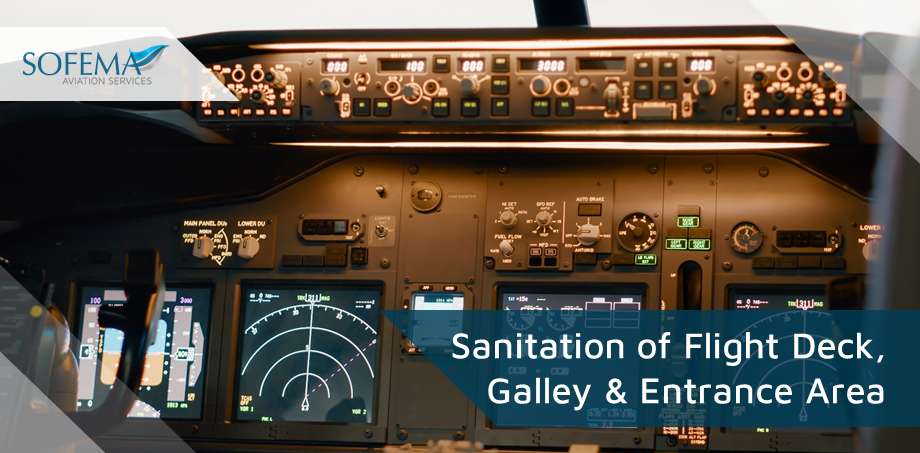Sofema Aviation Services (SAS) www.sassofia.com considers key aspects of the Flight Deck, Galley and Entrance Area Sanitation
While sanitation is of utmost importance, especially in the current global health climate, it’s essential to ensure that cleaning methods and agents are both effective and safe to use in the unique environment of an aircraft.
Sanitation in aircraft, especially in areas like the cockpit, galley, and entrance area, is crucial for ensuring the health and safety of both passengers and crew.
- Proper sanitation practices can prevent the spread of diseases and ensure a pleasant flying experience for everyone on board.
Introduction to Aircraft Flight Deck, Galley, and Entrance Area Sanitation
The following should be considered as part of the cleaning best practice management:
- Establish and adhere to a regular cleaning schedule. High-touch areas should be cleaned more frequently.
- Ensure that the cleaning agents used are suitable for aircraft interiors and won’t damage the materials or surfaces.
- Ensure that cleaning staff are well-trained on the specific cleaning protocols for aircraft and are aware of the importance of their role.
- Ensure proper ventilation during and after cleaning to dissipate any fumes from cleaning agents.
- Properly dispose of waste and cleaning materials to prevent contamination.
The following should be considered as part of the cleaning products and materials best practice management.
- Pre-moistened disinfectant wipes are convenient for cleaning high-touch surfaces. Ensure they are safe for aviation use.
- Isopropyl alcohol (70% or higher) can be effective against many pathogens. It’s safe for many surfaces but always test a small area first.
- Quaternary ammonium compounds (QACs) are sometimes referred to as quats. These compounds are among the most commonly used disinfectants in the food industry.
- Microfiber Cloths can effectively capture dirt and microbes and can be washed and reused.
- HEPA Vacuum Cleaners are useful for cleaning carpets and upholstery in the entrance and galley areas.
Important Notes & Cautions
- Avoid Bleach, while bleach is a powerful disinfectant, it can be corrosive and may damage aircraft interiors.
- Avoid Abrasive Materials, scrubbing pads or abrasive cleaners can damage surfaces, especially touchscreens in the cockpit.
- Always check the compatibility of cleaning agents with aircraft materials. Some agents can cause discolouration or degrade materials over time.
- Ensure that cleaning staff wear appropriate PPE, such as gloves and masks, to protect themselves from chemicals and pathogens.
- Avoid Excessive Moisture, especially in the cockpit, avoid using excessive moisture which can damage electronic equipment.
- Some cleaning agents can leave residues that might be harmful or cause allergic reactions. It’s essential to ensure surfaces are rinsed or wiped down properly.
- Some cleaning agents can emit fumes that might be harmful when inhaled. Proper ventilation is crucial.
- Some cleaning agents can be harmful to the environment. It’s essential to choose eco-friendly products when possible.
- The cockpit contains sensitive electronics. Ensure that cleaning methods do not introduce moisture or corrosive agents that could damage these systems.
Typical Flight Deck Cleaning
- Clean the cockpit after every flight, focusing on high-touch areas like control yokes, throttles, switches, and touchscreens.
- Use only aviation-approved disinfectants that won’t corrode or damage sensitive equipment.
- Ensure that cleaning solutions do not seep into electronic components. Use wipes or cloths that are damp, not wet.
Typical Galley Cleaning Considerations
- Clean the galley after every flight to ensure that it’s ready for the next set of passengers.
- Wipe down all surfaces, including countertops, cabinets, and appliances, with disinfectant wipes or a damp cloth.
- Periodically, the galley should undergo a deep cleaning, which might involve taking out removable parts of appliances and cleaning them separately.
o Clean the inside of ovens, microwaves, and refrigerators. Ensure that no food particles are left behind as they can attract pests or mold.
- Check and clean drains and sinks to prevent blockages and odours.
- Empty trash bins regularly and ensure they are cleaned and disinfected.
o Separate recyclables from non-recyclables to adhere to environmental standards.
Entrance Area Cleaning Considerations
- Door Handles and Surfaces: Disinfect door handles, railings, and other high-touch surfaces frequently.
- Floor Cleaning: The entrance area can accumulate dirt and debris from boarding. Regularly clean and disinfect the floor.
Next Steps
Follow this link to our Library to find & download related documents for Free.
Please see the following training course Aircraft Servicing, Cleaning, and Detailing for questions or comments please email team@sassofia.com
Tags:
aicraft cleaning, Aircraft, Aircraft Flight Deck, Aircraft Servicing, aviation, Aviation Training, Cleaning, EASA, Entrance Area, Entrance Area Sanitation, Flight Deck, SAS blogs, SAS training, Sofema Aviation Services




